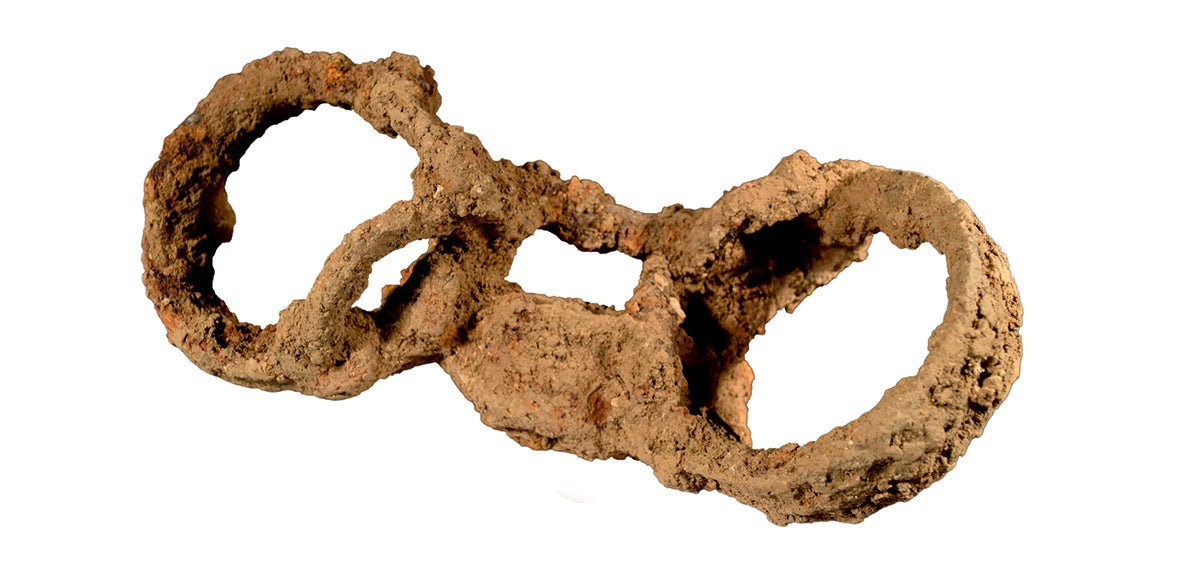Discovery of skeleton buried in chains provides rare evidence of slavery in Roman Britain
Man appears to have been poorly treated and abused in life, archaeologists say

Archaeologists have found rare evidence of slavery in Roman Britain in the form of a man buried in a ditch with a locked set of iron fetters around his ankles.
The discovery in Rutland, of a man thought to have been aged in his late 20s or mid 30s, is the first known burial of a person shackled in this form of restraint dating from the Roman occupation of Britain.
Builders working on a home extension in Great Casterton found the skeleton and radiocarbon dating undertaken by Leicestershire Police it dated from AD 226-427.
Archaeologists from the Museum of London Archaeology (MOLA) were brought in to expose, record and analyse the “internationally significant” find, with the results published in the journal Britannia.
While slavery was commonplace throughout the Roman Empire, the find is the first example of a burial of a man wearing lockable ankle fetters identified in Roman Britain, suggesting he may have been poorly treated and abused in life.
“To shackle somebody like this is probably quite a good indication that they’re a slave,” Michael Marshall, finds specialist at MOLA, told The Independent. “Not only that but they’re a slave who have been quite poorly treated because not all slaves live their lives in shackles, it seems to have been specifically a form of punishment, either a response to someone who tried to run away or in other ways had a bad relationship with their master.”
While the identity of the man will never be known for sure, the researchers think he led a physically demanding life. A bony spur on one if his upper leg bones could have been caused by a traumatic event such as a fall or blow to the hip, or a life filled with excessive or repetitive physical activity. However, the injury had healed by the time he had died, leaving the cause of death unknown.
The body was also buried in an awkward position, lying slightly on his right side with his left side and armed elevated on a slope, suggesting he was buried informally in a ditch rather than a proper grave.
Although there is a Roman cemetery around 60 metres away, it appears the man was buried just outside, suggesting there was a conscious effort to separate him from the people buried within.
“We think that the body lies outside of a nearby Roman cemetery and it looks almost like the body has been dumped into a ditch, which taken together with the shackles, implies mistreatment and quite a lot of disrespect of the body,” Mr Marshall said.
Slaves were very rarely buried in their shackles, which Mr Marhsall described as “pretty big chunks of iron and fairly sophisticated objects,” and which were often removed before slaves were buried.
The researchers suggested the man might have been buried in shackles as a way of punishment in the afterlife or as a warning to others.
“You have somebody who was either part of a pattern of systemic mistreatment, or perhaps an individual who rubbed his owner up the wrong way, and they chose to bury him in shackles,” Mr Marshall said. “I can’t get past the idea that somebody was trying to make a point. Whether that’s for the benefit of other people who are still alive, saying this person is a slave and will remain a slave even in death, or whether it is intended to have some sort of magical or religious dimension to it.”
He added that Roman written documents suggest there were beliefs that iron restraints could be used to prevent ghosts from walking or to stop people coming back from the dead.
“So you wonder if somebody has incredibly mistreated a person, and at the time the person dies they are worried about the implications of that if they are a suspicious person. They have some concerns about what the consequences of their actions might be and perhaps burying somebody with their feet shackled is a way to get around that,” Mr Marshall said.
MOLA archaeologist Chris Chinnock added: “The chance discovery of a burial of an enslaved person at Great Casterton, reminds us that even though the remains of enslaved people can often be difficult to identify, that they existed during the Roman period in Britain is unquestionable.
“Therefore, the questions we attempt to address from the archaeological remains can, and should, recognise the role slavery has played throughout history.”
Subscribe to Independent Premium to bookmark this article
Want to bookmark your favourite articles and stories to read or reference later? Start your Independent Premium subscription today.

Join our commenting forum
Join thought-provoking conversations, follow other Independent readers and see their replies